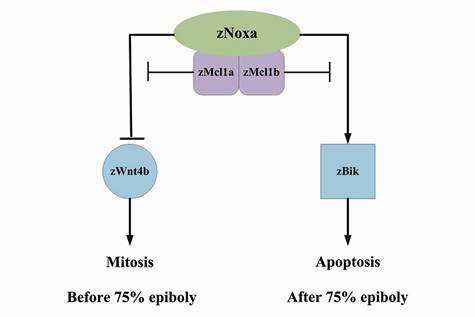
Newsroom
Essential Functions for Noxa in Zebrafish Embryonic Development
In mammals, proapoptotic BH3-only protein Noxa is a member of Bcl-2 family and a candidate mediator of p53-dependent apoptosis through mitochondrial dysfunction. Noxa also may perform functions in the immune system. However, its exact functions have remained unclear in early embryonic development of zebrafish.

Theproposed function relationship among zNoxa, zMcl1a, zMcl1b, zWnt4b, and zBik in regulating mitosis and apoptosis before and after 75% epiboly in zebrafish embryos. (Image/IHB)
The research group led by Prof. GUI Jianfang at Institute of Hydrobiology, Chinese Academy of Sciences (IHB) has characterized the zebrafish homologue zNoxa of mammalian Noxa, and observed its ubiquitous expression and distribution in early embryo stages, suggesting that zNoxa might be important in early embryonic development. They have found for the first time that zNoxa is able to cooperate with zMcl1a and zMcl1b, and regulates mitosis through zWnt4b in early zebrafish embryonic development before 75% epiboly stage.
In subsequent embryogenesis after 75% epiboly stage, zNoxa firstly induces the expression of zBik, and then cooperates with zBik to regulate apoptosis. Moreover, they have further revealed that zMcl1a and zMcl1b suppress the ability of zNoxa to regulate mitosis and apoptosis at different developmental stages.
In summary, this study has demonstrated that zNoxa is a novel regulator of cell mitosis except a key mediator of apoptosis during zebrafish embryogenesis, and it plays distinct roles at different developmental stages. Obviously, the new finding is very important for scientists to understand genetic basis and physiological roles of significant function genes in fish and even in vertebrates.
The research findings were published online in the Cell Death and Differentiation with the title "Zebrafish Noxa promotes mitosis in early embryonic development and regulates apoptosis in subsequent embryogenesis". This work was funded by the National Key Basic Research Program of China, the Special Fund for Agro-scientific Research in the Public Interest, the Innovation Project of Chinese Academy of Sciences, and the Autonomous Project of the State Key Laboratory of Freshwater Ecology and Biotechnology.